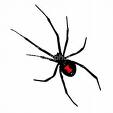Black Widow Spider
Lactrodectus mactans
 |
|
The typical adult female black widow has a shiny black body, slender black legs, and a red or orange mark in the shape of an hourglass on the underside of the large, round abdomen. The adult male black widow is one-half to two-thirds the length of the female, has a smaller abdomen, and is seldom recognized as a black widow. The topside of its abdomen is greenish gray with a pattern of cream-colored areas and one light-colored band going lengthwise down the middle. The hourglass mark on the underside of the abdomen typically is yellow or yellow-orange and broad in the middle. The legs are banded with alternating light and dark areas. Like males, young female black widow spiders are patterned on the top side. In the early stages they resemble males, but gradually acquire the typical female coloration with each molt. In intermediate stages they have tan or cream-colored, olive gray, and orange markings on the topside of the abdomen, a yellowish orange hourglass mark on the underside and banded legs. The egg sacs are mostly spherical, about 1/2 inch long and 5/8 inch in diameter, creamy yellow to light tan in color, opaque, and tough and paperlike on the surface. A female may produce several egg sacs during her lifetime, which can be 2 years. Tiny, young black widows, which are nearly white in color, emerge from the egg sac and remain close together during the first days after emergence, often preying on each other. Soon afterwards, the spiderlings disperse to new locations by \\\'ballooning\\\' on light silken thread and infest new areas. Webbing produced by black widow spiders is very strong compared to other spider webbing.
Habits
Black widow spiders spin their webs near ground level. They often build their webs in protected areas, such as in boxes and in firewood, in upside down buckets and the inside of tires.
Habitat
Black widow spiders are often found around wood piles and gain entry into a structure when firewood is carried into a building. They are also found under eaves, in boxes, and other areas where they are undisturbed.
Threats
Generally spiders play a beneficial predatory role in a vineyard and are not thought of as pests. However, in the southern San Joaquin Valley (Kern and Tulare counties) and the Coachella Valley, black widow spiders can be a problem in table grape vineyards because of quarantine issues in crops to be exported to other countries and because of the public\\\'s fear of black widows.
Prevention:
Avoid black widow spider bites by wearing heavy gloves when moving items that have been stored for a long period of time. Spiders often hide in shoes, so check shoes and shake them out before wearing. When spider webs are visible, use caution before putting your hands or feet in that area.


